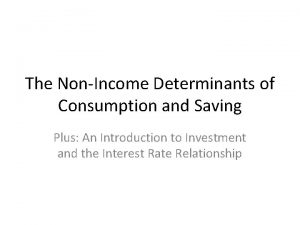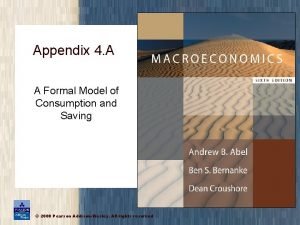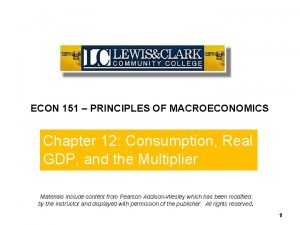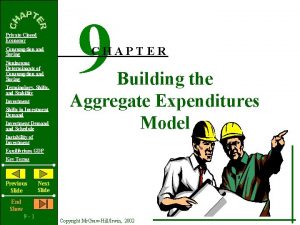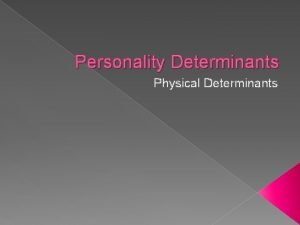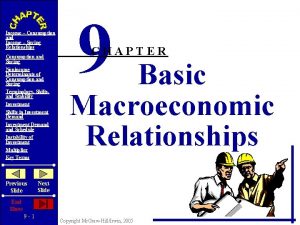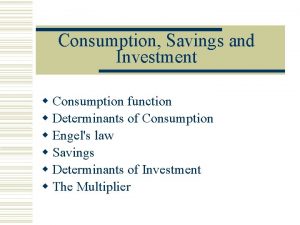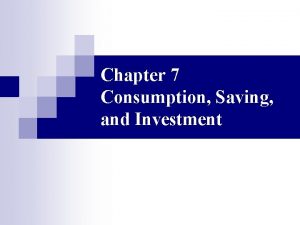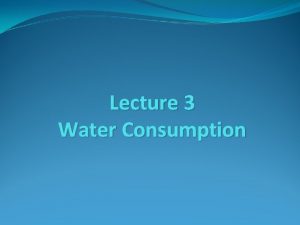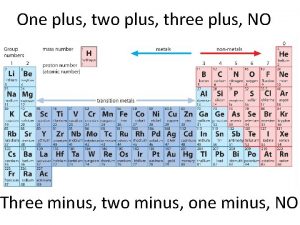The NonIncome Determinants of Consumption and Saving Plus











- Slides: 11

The Non-Income Determinants of Consumption and Saving Plus: An Introduction to Investment and the Interest Rate Relationship

The Non-DI Determinants of Consumption and Savings Wealth Expectations Taxation Household Debt

Wealth • The value of real assets (houses, land) and financial assets (cash, stocks, bonds). • When wealth increases, households increase spending and reduce savings. • This is called the wealth effect, and it shifts the savings schedule down, and consumption up. • The opposite occurs when wealth decreases.

Expectations • About future prices and income. • Expectations of rising prices in the future will cause an increase in consumption and decrease in saving. • This shifts the consumption schedule upward and savings downward. • The opposite occurs when there are expectations of a recession or lower income.

Taxation • Taxes are paid at the expense of consumption and savings. • If taxes increase, we save and consume less. • Conversely, tax reductions by the government encourage us to buy and save more. • Thinking & Inquiry: Why might the government be afraid to raise taxes to pay off the debt during a slow economy?

Household Debt • Increased borrowing increases current consumption. This moves the consumption schedule up. • Decreased borrowing reduces consumption. • Thinking & Inquiry: Why at high levels does increasing levels of debt cause serious problems for future savings and consumption?

Curve Analysis: “Movement” versus “Shift. ”

Making Investment Decisions: The Main Determinants Expected Rate of Return • Expressed as (r) Interest Rate on Borrowed Money • Expressed as (i)

Expected Rate of Return • Businesses only make investments when they expect them to be profitable. r = (Expected Revenue - cost of investment) / cost of investment. • Firms are risk takers, and returns are not guaranteed.

The Real Interest Rate and Analysis • Businesses only invest when the rate of return is greater than the interest rate (r > i) • You take out a loan for $1000 to buy a machine. If the interest rate is 7%, you pay $70 in interest. • If the rate of return is 10%, then you generate $100 extra from the machine. • Your net profit is $30 ($100 -$70)

Test Preparation • In groups of four, read 191 -193. • Try to explain what you read to each other in simple and clear language. • Discuss and complete the following potential test questions: # 4 and # 6 on pg. 223.
 Non income determinants of consumption and saving
Non income determinants of consumption and saving The life-cycle model of consumption and saving
The life-cycle model of consumption and saving Determinants of consumption
Determinants of consumption Determinants of consumption
Determinants of consumption Jerusalem cite de dieu chant
Jerusalem cite de dieu chant Je contiens du sucre sans être sucré qui suis-je
Je contiens du sucre sans être sucré qui suis-je Okres jury i kredy
Okres jury i kredy Plus j'apprends plus je me rends compte de mon ignorance
Plus j'apprends plus je me rends compte de mon ignorance Prepare food definition
Prepare food definition Ethics of food production and consumption
Ethics of food production and consumption Sacred and profane consumption
Sacred and profane consumption Sacred and profane consumption
Sacred and profane consumption
